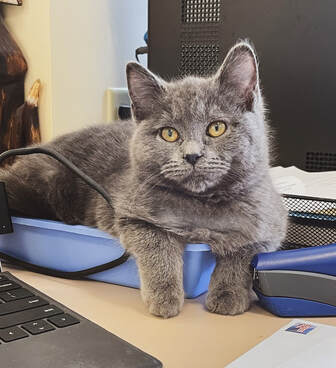What is diabetes mellitus?
Diabetes mellitus is a medical condition resulting in an excessive amount of glucose, or sugar, in the blood. This is caused by a deficiency of insulin, which is a hormone secreted by the pancreas.
The clinical signs seen in diabetes are largely related to the elevated concentrations of blood glucose and the inability of the body to use glucose as an energy source due to the deficiency of insulin.
Diabetes mellitus affects an estimated one in four hundred cats, and is seen more frequently in middle to senior-age cats, and is more common in males than in females.
What are the clinical signs of diabetes mellitus?
The most common clinical sign seen in diabetic patients are an increase in water consumption and urination. Weight loss is also a common feature, and an increase in appetite may be noticed in some cats. Recognition of these signs is variable, particulary because of the lifestyle of some cats. If a cat spends a lot of time outdoors, it may drink from ponds or pools of water outside than appearing to drink excessively from what is provided indoors. Cats that are fed canned or moist diets recieve much of their water intake from their diet, and increased water intake will be less easily recognized in these patients.
How is diabetes mellitus diagnosed?
The diagnosis of diabetes mellitus is made based on clinical signs, persistently elevated blood glucose concentration, and the presence of glucose in the urine. However, a diagnosis of diabetes cannot be made on a single blood and urine sample because other conditions, such as stress, may also cause a transient rise in glucose levels. Confirmation of diabetes may therefore require more than one blood sample collected over a period of one to five days.
How is diabetes mellitus treated?
Diabetes mellitus is a treatable condition. Although long-term treatment requires commitment and dedication, it can be rewarding to successfully manage this condiiton in a beloved pet.
Initial steps in treating a diabetic cat may involve removal of any predisposing causes for the diabetes. For example, the administration of some drugs predisposes cats to develop diabetes and withdrawal of these drugs may lead to resolution of the condition. Obese cats are more prone to developing diabetes, and weight reduction can lead to resolution of the signs in some cats.
If there are no predisposing causes, or if correction of the predisposing causes does not lead to resolution of the diabetes, specific treatment is required. Although a small proportion of cats will respond to oral hypoglycemic medication, most cats will require insulin injections to control the diabetes.
During the intial stages of treatment, your cat will require several hospital visits until an appropriate insulin dosage is determined. Most cats will achieve initial stabilization within a few days to a few weeks. Many cats will require once or twice daily injections of a small dose of insulin. Small needles are available which cause no pain to the cat, and within a short period of time, the procedure becomes routine. Administration times, dosages, and type of insulin will be determined by your veterinarian.
Do treated cats need to be monitored?
Yes, it is important to monitor treatment to make sure it is working properly and to determine if any insulin dosage adjustments are necessary.
Monitoring can be done in part through the collection of occasional blood samples by your veterinarian, but it is particularly valuable to keep accurate records of the following information:
Daily records
- Time of insulin injection
- Amount of insulin injected
- Amount and time of food fed and eaten
- Water Intake
Weekly records
- Weight of the cat
In addition to these records, it can be valuable to monitor the quatity of glucose passed in the urine as a guide to the effectiveness of the treatment. This is best done on urine that is passed during the night or first thing in the morning. To collect urine, it is usually easiest to replace the normal cat litter with clean and unwashed aquarium gravel at night, which will not soak up any urine passed. The urine collected can either be tested by your veterinarian, or with a kit to test it yourself. If there is any mrked change in the amount of glucose in the urine, this may indicate the need to alter the insulin dose, but you should never change the dose of insulin without first discussing it with your veterinarian. Changes in the insulin are usually based on trends in urine glucose concentrations, as there is normally some day to day variation.
What happens if my cat receives to much insulin?
If a cat receives too much insulin, it is possible for the blood sugar level to drop dangerously low. For this reason, it is important to be very careful in ensuring the cat receives the correct dose of insulin.
The typical signs displayed by a cat with a very low blood sugar level are weakness and lethargy, shaking, unsteadiness and even convulsions. If a diabetic cat shows any of these signs, it is important to seek immediate veterinary advice or attention. In mild cases of hypoglycemia, you may observe a “wobbling” or “drunken” walk or appearance, and the cat may not arouse when you call or pet them. If you notice any of these symptoms, please seek veterinary advice or attention. If more severe signs are displayed, such as ataxia, or severe incoordination and unsteadiness during walking, or convulsions, you should seek immediate veterinary care. Your veterinarian can advise you on specific emergency treatment of low blood sugar in your cat.
As always, if you have any question or concerns, call your veterinarian today!

